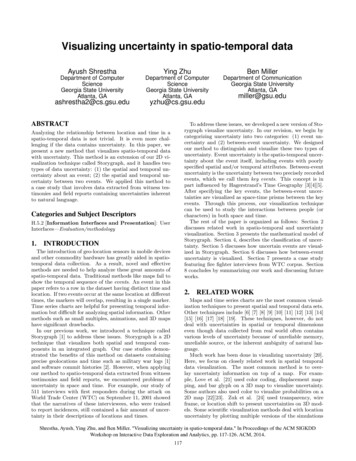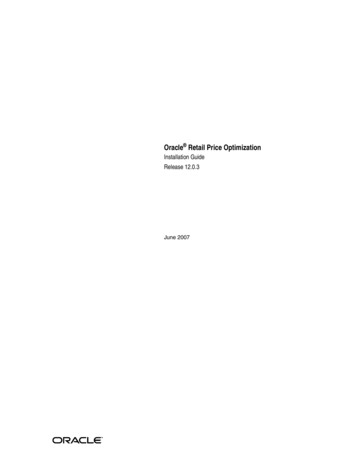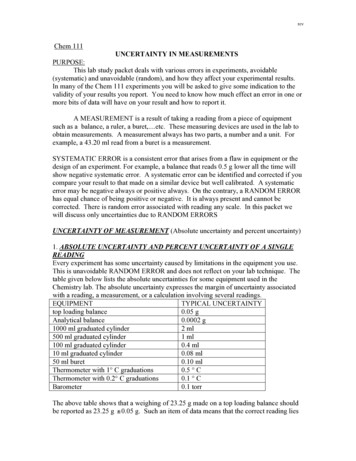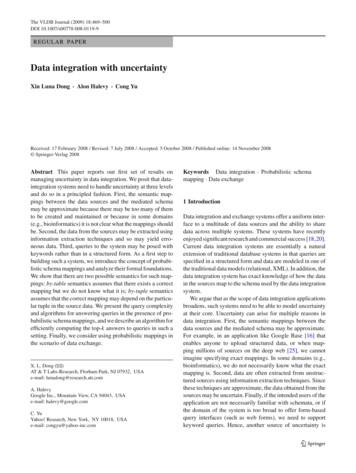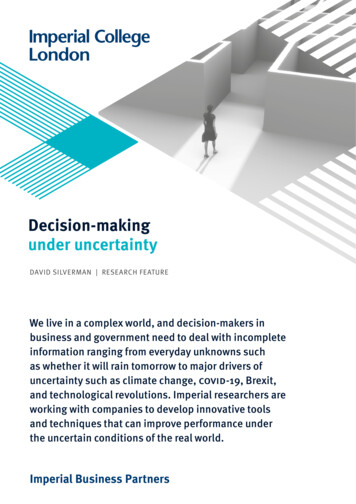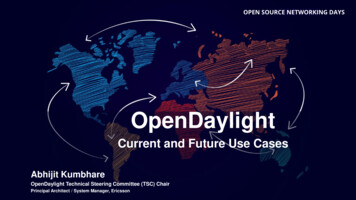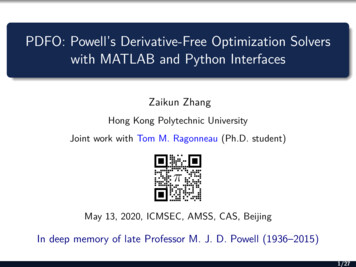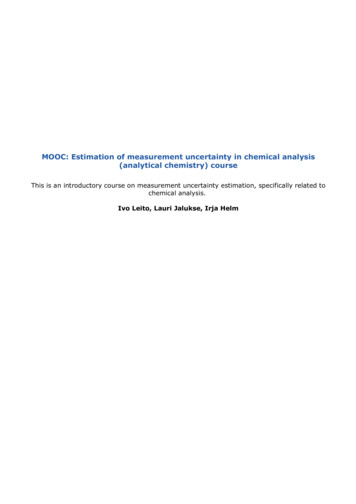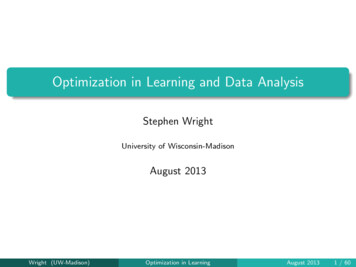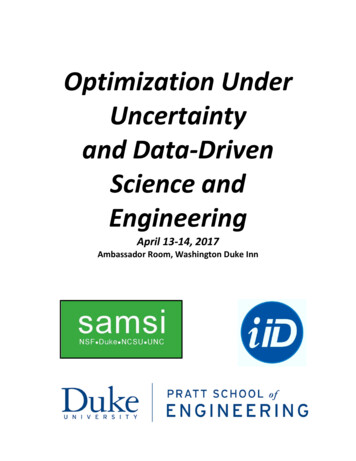
Transcription
Optimization UnderUncertaintyand Data-DrivenScience andEngineeringApril 13-14, 2017Ambassador Room, Washington Duke Inn
Optimization Under Uncertaintyand Data-Driven Science and EngineeringApril 13-14, 2017Ambassador Room, Washington Duke 03:404:205:005:406:00Thursday, April 13RegistrationOpeningTerry Rockafellar, Solving Stochastic Variational Inequalities by Progressive HedgingDrew Kouri, A Data-Driven Approach to PDE-Constrained Optimization underUncertaintyBreak-Rotunda (open 9-5pm)Guillermo Sapiro, Learning to OptimizeMadeleine Udell, Sketchy Decisions: Convex Low-Rank Matrix Optimization withOptimal StorageLunch- BuffetAlexander Shapiro, Computational complexity of stochastic programsJonathan Mattingly, Analyzing MCMC and Streaming algorithms in high-dimensionsthrough scaling limitsBreak-Rotunda (open 9-5pm)Stan Uryasev, Classification with Error Control using Buffered ProbabilityGenetha Gray, Uncertainty Quantification of Big Data Applied to Autonomous VehiclesJohannes Royset, Risk-Tuned Prediction and DesignEnd of technical talksPoster session-Ambassador Room: hors d'oeuvres, open barFriday, April 14Steven Low, Optimal Power Flow: Online Algorithm and Fast DynamicsSantiago Grijalva, Decentralized Coordination in Transactive Energy Prosumer NetworksBreak-Rotunda (open 9-5pm)Lang Tong, Probabilistic Forecasting and Simulation of Real-time Electricity Markets viaOnline Dictionary Learning11:20 Michael Zavlanos, Distributed Optimization Algorithms for Networked Systems12:00 Lunch- Sandwich Cart2:00 Ingrid Daubechies, Bones, Teeth and Animation2:40 Noemi Petra, Mean-variance risk-averse optimal control of systems governed by PDEswith random parameter fields using quadratic approximations3:20 Break-Rotunda (open 9-5pm)3:40 Bart Van Bloemen Waanders, Data Analysis and Risk Averse Optimization for AdditiveManufacturing4:20 Sayan Mukherjee, Inference in Dynamical Systems5:00 End of workshop9:009:4010:2010:40Many thanks to our sponsors: SAMSI, Information Initiative at Duke, Pratt School of Engineering
Terry Rockafellar, University of WashingtonSolving Stochastic Variational Inequalities by Progressive HedgingVariational inequalities are a modeling tool for problems of optimization and equilibrium, but also have a long-standing role inextending partial differential equations'' to the possibility of inequations'' coming from obstacles. Stochastic variationalinequalities incorporate uncertainty and thus have a bearing on uncertainty quantification, but they can stand for optimalityand equilibrium conditions in a single-stage or multi-stage environment as well. Besides explaining that framework, this talkwill show how, in the presence of monotonicity (in the operator sense), solutions can be obtained by the progressive hedgingalgorithm.Drew Kouri, Sandia National LabsA Data-Driven Approach to PDE-Constrained Optimization under UncertaintyMany science and engineering applications require the optimal control or design of a physical system governed by partialdifferential equations (PDEs). More often then not, PDE inputs such as coefficients, boundary conditions and initial conditionsare unknown and estimated from noisy, incomplete data. In this talk, I will discuss the theoretical challenges associated withsuch PDE-constrained optimization problems, including their mathematical formulation and their efficient numerical solution.First, I will assume that the probability distributions characterizing the uncertain PDE inputs are known. For this case, I willreview risk measures as a means for quantifying the "hazard" associated with large objective function values. Next, to handlethe situation of unknown probability distributions, I will introduce and analyze a distributionally-robust formulation for theoptimization problem. To enable numerical solutions, I will present a novel discretization for the unknown probability measureand provide rigorous error bounds for this approximation. I will conclude with numerical results confirming the aforementionedbounds.Guillermo Sapiro, Duke UniversityLearning to OptimizeIn this talk I will describe some of our early work on how to adapt optimizers to the data and task, achieving orders ofmagnitude speed-ups. This is joint work with P. Sprechmann and A. Bronstein, with additional theoretical foundation with R.Giryes and Y. Eldar.Madeleine Udell, Cornell UniversitySketchy Decisions: Convex Low-Rank Matrix Optimization with Optimal StorageIn this talk, we consider a fundamental class of convex matrix optimization problems with low-rank solutions. We show it ispossible to solve these problems using far less memory than the natural size of the decision variable when the problem datahas a concise representation. Our proposed method, SketchyCGM, is the first algorithm to offer provable convergence to anoptimal point with an optimal memory footprint. SketchyCGM modifies a standard convex optimization method — theconditional gradient method — to work on a sketched version of the decision variable, and can recover the solution from thissketch. In contrast to recent work on non-convex methods for this problem class, SketchyCGM is a convex method; and ourconvergence guarantees do not rely on statistical assumptions.Alexander Shapiro, Georgia Institute of TechnologyComputational Complexity of Stochastic ProgramsThe traditional approach to solving stochastic programming problems involves discretization of the underlying probabilitydistributions. However, the number of required discretization points (called scenarios) grows exponentially both with increaseof the number of random parameters and number of stages. In order to deal with this exponential explosion, randomizationapproaches based on Monte Carlo sampling techniques were developed. In this talk we discuss computational complexity ofsome of such methods from theoretical and practical points of view.Jonathan Mattingly, Duke UniversityAnalyzing MCMC and Streaming algorithms in high-dimensions through scaling limitsI will discuss the high dimensional scaling limits of some Markov Chain algorithms in Monte Carlo and streaming applications.The limits will consist of stochastic, as well as deterministic, PDEs and Non-linear PDEs which come from a mean-field limit.The talk will be based on older work with Andrew Stuart (Caltech) and Natesh Pillai (Harvard) and ongoing work with Yue Lu(Harvard) and Chuang Wang (Harvard).Stan Uryasev, University of FloridaClassification with Error Control using Buffered ProbabilityWe present a new classification paradigm with error control inspired by the Neyman-Pearson (NP) classification. Standard NPclassification minimizes False Positive Rate (FPR) with constrained False Negative Rate (FNR). Our approach, which is called bNPclassification, is a new counterpart for NP classification. bNP classification is derived from the Buffered Probability of
Uncertainty Quantification of Big Data Applied to Autonomous VehiclesDetermining the likelihood of specific outcomes despite the lack of complete system knowledge is central to the use ofpredictive simulation. To date, the development of uncertainty quantification (UQ) tools has focused primarily on data-poorapplication or "small data" environments. However, many of today's problems are characterized by "big data" or collections ofdata too large and complex for traditional processing techniques. While tools have been developed to analyze big data, theassociated uncertainties and their impacts to are yet to be well defined or understood. In this talk, we will consider UQmethodology for applications related to autonomous vehicles (AV). Each hour, an AV can collect one terabyte ofheterogeneous data from car positioning to camera images. Such data sets cannot simply be analyzed by applying existing UQmethodologies as the quantity of data can add intractable complexities or impossible computational workload requirements.Moreover, simplistic sampling or down selecting the data may lead to lost information or useless risk assessments. We willreview alternative approaches to UQ and describe their importance in the development of AV systems.Johannes Royset, Naval Postgraduate SchoolRisk-Tuned Prediction and DesignEngineering decisions are invariably made under substantial uncertainty about current and future system cost and response,including cost and response associated with low-probability, high-consequence events. We review models for decision makingbased on superquantile risk (s-risk) that comprehensively capture uncertainty, avoid paradoxes, and accrue substantial benefitsin risk, reliability, and cost optimization. We describe methods for predicting s-risk at reduced computational cost using multifidelity simulations and give examples from earthquake engineering, naval architecture, and energy management.Steven Low, CaltechOptimal Power Flow: Online Algorithm and Fast DynamicsWe are at the cusp of a historical transformation of our power systems into a more sustainable, dynamic, and intelligentnetwork with hundreds of millions of distributed energy resources. One of the key challenges in this transformation is thecontrol and optimization of such a large-scale cyberphysical system. The optimal power flow (OPF) problem underliesnumerous system operation and planning applications. Traditional OPF algorithms are offline in that they solve power flowequations explicitly or implicitly, and iteratively until the computation has converged before applying the final solution. This iscomputationally challenging because power flow equations are nonlinear. The grid however implicitly solves power flowequations in real-time at scale for free. We describe two methods to explicitly exploits the network as a power flow solver tocarry out part of our optimization algorithm. This approach naturally adapts to evolving network conditions.Specifically, we present algorithms that adapt controllable devices and interacts continuously with the grid which computes apower flow solution given a control action. Collectively these devices and the grid implement a gradient algorithm in real time.We characterize optimality and tracking performance. We apply this idea to ubiquitous load-side frequency control at a fasttimescale that integrates primary frequency regulation, secondary frequency regulation, and congestion management. Weprove sufficient conditions under which the algorithm converges to a global optimum.Santiago Grijalva, Georgia Institute of TechnologyDecentralized Coordination in Transactive Energy Prosumer NetworksEnergy prosumers are economically motivated subsystems that can consume, produce or store electricity. They emergenaturally from the deployment of distributed energy resources (DERs) such as solar, wind, demand response, energy storage,electric vehicles, etc. Energy prosumers include homes, buildings, microgrids, as well as larger subsystems. Connected throughcommunication networks, and equipped with distributed computing, prosumers become “energy aware” and can locally andintelligently optimize their energy utilization. However, in order to maintain the functionality, security, and resilience of theoverall electricity grid, they must coordinate with each other in a decentralized and provable manner. This talk will describearchitectures and methods for massively scalable decentralized coordination among energy prosumers at the control andoptimization (scheduling) time scales. We will present novel results on algorithmic development and their performance on DERrich networks, demonstrating scalability. We will describe the elements of transactive energy services platforms to realizedecentralized prosumer coordination.Lang Tong, Cornell UniversityProbabilistic Forecasting and Simulation of Real-time Electricity Markets via Online Dictionary LearningThe dramatic increase of the behind-the-meter solar integration in recent years has fundamentally changed the overall netloadcharacteristics. In some areas, the traditional load profile is being transformed to the so-called “duck curve” profile where asteep downramp when a large amount of solar power is injected is followed by a steeper up-ramp when the solar power dropssharply in the late afternoon and early evening hours. While the duck curve phenomenon represents an average behavior, it isthe highly stochastic and spatial-temporal dependent ramp events that present difficult operational challenges to systemoperators. In this talk, we consider the problem of online forecasting and simulation of real-time system operations. By onlineforecasting and simulation we mean in particular using real-time SCADA and PMU measurements to produce conditionalprobability distributions of future nodal prices, power flows, power dispatch levels, and discrete events such as occurrences ofcongestion and system contingencies. An online dictionary learning technique is proposed to achieve several orders ofmagnitude of improvement in computation time over standard Monte Carlo techniques.
Michael Zavlanos, Duke UniversityDistributed Optimization Algorithms for Networked SystemsDistributed optimization methods allow to decompose an optimization problem into smaller, more manageable subproblemsthat are solved in parallel. For this reason, they are widely used to solve large-scale problems arising in areas as diverse aswireless communications, optimal control, machine learning, artificial intelligence, computational biology, finance, andstatistics, or problems with a separable structure that are amenable to distributed implementations. In this talk we present theAccelerated Distributed Augmented Lagrangians (ADAL) algorithm, a novel decomposition method for optimization problemsthat involve a separable convex objective function subject to convex local constraints and linear coupling constraints.Optimization using Augmented Lagrangians (ALs) combines the low computational complexity of first order optimizationmethods with fast convergence speeds due to the regularization terms included in the AL. In its centralized version,optimization using ALs is an excellent general purpose method for constrained optimization problems and enjoys a largeamount of literature. However, decentralized methods that employ ALs are few, as decomposition of ALs is a particularlychallenging task. We establish convergence of ADAL and show that it has a worst-case O(1/k) convergence rate. Moreover, weshow that ADAL converges to a local minimum of the problem when the objective function is non-convex, and that it canhandle uncertainty and noise in which case it generates sequences of primal and dual variables that converge to theirrespective optimal sets almost surely. We provide numerical simulations for wireless network optimization problems thatsuggest that the proposed method outperforms the state-of-the-art distributed Augmented Lagrangian methods that areknown in the literature. Moreover, we present a Random Approximate Projections (RAP) method for decentralized optimizationproblems with SDP constraints. Unlike other methods in the literature that employ Euclidean projections onto the feasible set,our method is computationally inexpensive as it relies only on subgradient steps in the direction that minimizes the localconstraint violation. We show that the algorithm converges almost surely and can also handle inexact problem data. Wedemonstrate our approach on a distributed estimation problem involving networks of mobile sensors estimating a set of hiddenstates that are governed by linear dynamics up to a user-specified accuracy.Ingrid Daubechies, Duke UniversityBones, Teeth and AnimationThe talk describes new distances between pairs of two-dimensional surfaces (embedded in three-dimensional space) that useboth local structures and global information in the surfaces. These are motivated by the need of biological morphologists tocompare different phenotypical structures, to study relationships of living or extinct animals with their surroundings and eachother. This is typically done from carefully defined anatomical correspondence points (landmarks) on e.g. bones.Unlike other algorithms presented for morphological correspondences, our approach does not require any preliminary markingof special features or landmarks by the user. It also differs from other seminal work in computational geometry in that ouralgorithms are polynomial in nature and thus faster, making pairwise comparisons feasible for significantly larger numbers ofdigitized surfaces. The approach is illustrated using three datasets representing teeth and different bones of primates andhumans; it is shown that it leads to highly accurate results.Noemi Petra, University of California, MercedMean-variance Risk-averse Optimal Control of Systems Governed by PDEs with Random Parameter Fields uUsing QuadraticApproximationsWe present a method for optimal control of systems governed by partial differential equations (PDEs) with uncertain parameterfields. We consider an objective function that involves the mean and variance of the control objective, leading to a risk-averseoptimal control problem. To make the optimal control problem tractable, we invoke a quadratic Taylor series approximation ofthe control objective with respect to the uncertain parameter field. This enables deriving explicit expressions for the mean andvariance of the control objective in terms of its gradients and Hessians with respect to the uncertain parameter. The risk averseoptimal control problem is then formulated as a PDE-constrained optimization problem with constraints given by the forwardand adjoint PDEs defining these gradients and Hessians. The expressions for the mean and variance of the control objectiveunder the quadratic approximation involve the trace of the (preconditioned) Hessian, and are thus prohibitive to evaluate. Toovercome this difficulty, we employ randomized trace estimators. We illustrate our approach with two specific problems: thecontrol of a semilinear elliptic PDE with an uncertain boundary source term, and the control of a linear elliptic PDE with anuncertain coefficient field. For the latter problem, we derive adjoint-based expressions for efficient computation of thegradient of the risk-averse objective with respect to the controls. Our method ensures that the cost of computing the riskaverse objective and its gradient with respect to the control-measured in the number of PDE solves-is independent of the(discretized) parameter and control dimensions, and depends only on the number of random vectors employed in the traceestimation. Finally, we present a comprehensive numerical study of an optimal control problem for fluid flow in a porousmedium with uncertain permeability field.Bart Van Bloemen Waanders, Sandia National LaboratoriesData Analysis and Risk Averse Optimization for Additive ManufacturingAdditive manufacturing (AM) is capable of creating compelling designs at a much faster rate than standard methods. However,achieving consistent material properties at various length scales remains a challenge. In this work, we present risk-averseoptimization to produce robust designs by tightly controlling certain features of the dynamics while addressing underlyinguncertainties. Aspects of the AM process are emulated with PDEs to mimic the behavior of the material during the processing.
The goal is to control different aspects of the dynamics, such as source terms and boundary conditions, to achieve designtargets and simultaneously accomodate uncertainties in different parts of the underlying dynamics.PDE-constrained optimization methods serve as the foundation for this work with finite element discretizations, adjoint-basedsensitivities, trust-region methods, and Newton-Krylov solvers. Our final AM produced parts must achieve tight tolerances for arange of different material properties. Accordingly, risk-averse methods are considered with a specific emphasis on reliability. Anumerical example demonstrates that the use of risk measures results in optimal solutions and ensures that worse casescenarios are avoided.Sayan Mukherjee, Duke UniversityInference in Dynamical SystemsWe consider the asymptotic consistency of maximum likelihood parameter estimation for dynamical systems observed withnoise. Under suitable conditions on the dynamical systems and the observations, we show that maximum likelihood parameterestimation is consistent. Furthermore, we show how some well-studied properties of dynamical systems imply the generalstatistical properties related to maximum likelihood estimation. Finally, we exhibit classical families of dynamical systems forwhich maximum likelihood estimation is consistent. Examples include shifts of finite type with Gibbs measures and Axiom Aattractors with SRB measures. We also relate Bayesian inference to the thermodynamic formalism in tracking dynamicalsystems. We state conditions for consistency of a Gibbs distribution using classic ideas from dynamical systems such astopological entropy and pressure.PostersOlalekan Babaniyi, Duke UniversityPDE-Constrained Optimization Techniques for Bio-Mechanical ImagingAndres Contreras, Duke UniversityParallel Domain Decomposition Strategies for Stochastic Elliptic EquationsHenri Gavin, Duke UniversityConstrained Optimal ControlDmitry Kalika, Duke UniversityAdaptive Querying in ERP-based Brain-computer Interfaces Using Maximum Expected Discrimination GainAlicia Kim, University of California San DiegoM2DO: Multiscale Multiphysics Design OptimizationVarun Mallampalli, Duke UniversityUncertainty and the Green ParadoxVaishakhi Mayya, Duke UniversityThe P300-based Brain-computer Interface as a Communication Channel with MemoryMatthew Norton, University of FloridaMaximization of AUC and Buffered AUC in Binary ClassificationClay Sanders, Duke UniversityPDE-Constrained Optimization for the Design of Acoustic CloaksDaniel Seidl, Sandia National LaboratoriesMultiscale Interfaces for Large Scale OptimizationMatthew Zahr, Lawrence Berkeley National LaboratoriesEfficient PDE-Constrained Optimization using Adaptive Model ReductionZilong Zou, Duke UniversityLocal Sample-Based Approximations to Partial Differential Equations with Stochastic Parameters
and Data-Driven Science and Engineering . April 13-14, 2017. Ambassador Room, Washington Duke Inn . Thursday, April 13 . 8:00 Registration. 8:40 . Opening. 9:00 . Terry Rockafellar, Solving Stochastic VariationalInequalities by Progressive Hedging . 9:40 . Drew Kouri, A Data-Driven Approach to PDE -Constrained Optimization under Uncertainty
